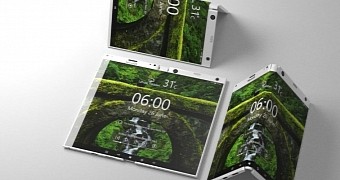Microsoft is more or less out of the smartphone business, but the company still doesn’t want to give up on mobile entirely, so it’s now working on a device that could let it be part of this industry with a completely new form factor.
Not a long time ago, we learned that Microsoft was working on a Courier-like digital note taking device that could incorporate phone capabilities, and now Brad Sams of Thurrott writes that the project involves a dual-screen setup with a foldable display.
Microsoft obviously wants to make the most of the available screen space on such a device, so the firm is working internally on UWP apps are that are being specifically optimized for dual-panel displays, with pen input considered to be a priority. Features that have until now been available in OneNote will be expanded to Mail, Calendar, and others.
The more innovative feature is the holographic display which Microsoft is apparently considering for the new mobile device. HoloLens creator Alex Kipman is the go-to person in this regard, and Microsoft wants the new device to be able to show holograms.
Making calls still possible
The report states that phone capabilities are likely to be offered, though the device won’t be a Surface Phone itself. First and foremost, it’ll be a note-taking device whose capabilities are focused on the pen, but making calls will still be possible. LTE will clearly be offered for on-the-go Internet connectivity.
Most likely, Microsoft will use Windows 10 on ARM to power the device, as the company claims one-day battery life on notebooks, so such an implementation could go beyond that without compromising the power of Windows 10.
What’s important to know, however, is that the next Microsoft mobile device will be a super-expensive gadget, and the software giant isn’t aiming to build too many units. It’ll be a low-volume product, the report states, and this means it won’t come cheap, especially given the tech bundled inside.
But Microsoft probably aims to use it as a pioneer of a new form factor, similar to the original Surface model, and allow partners to build their own models at a lower price.

 14 DAY TRIAL //
14 DAY TRIAL //